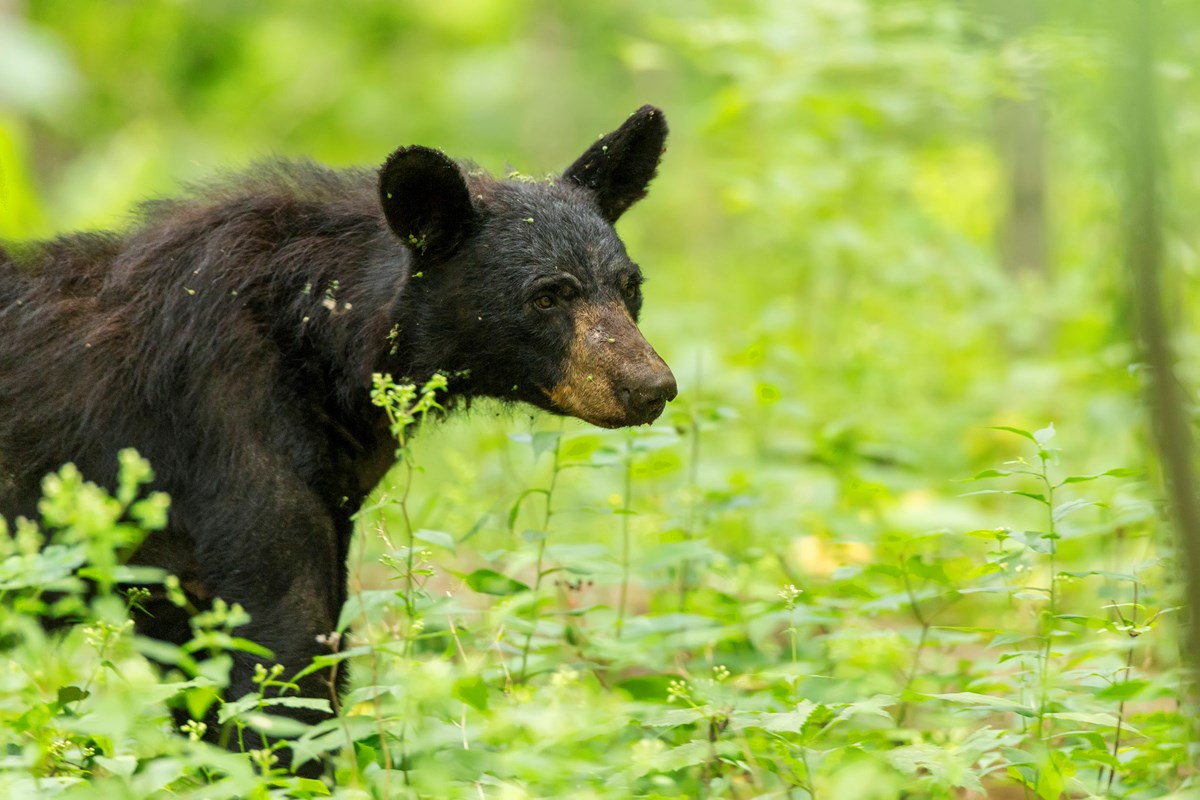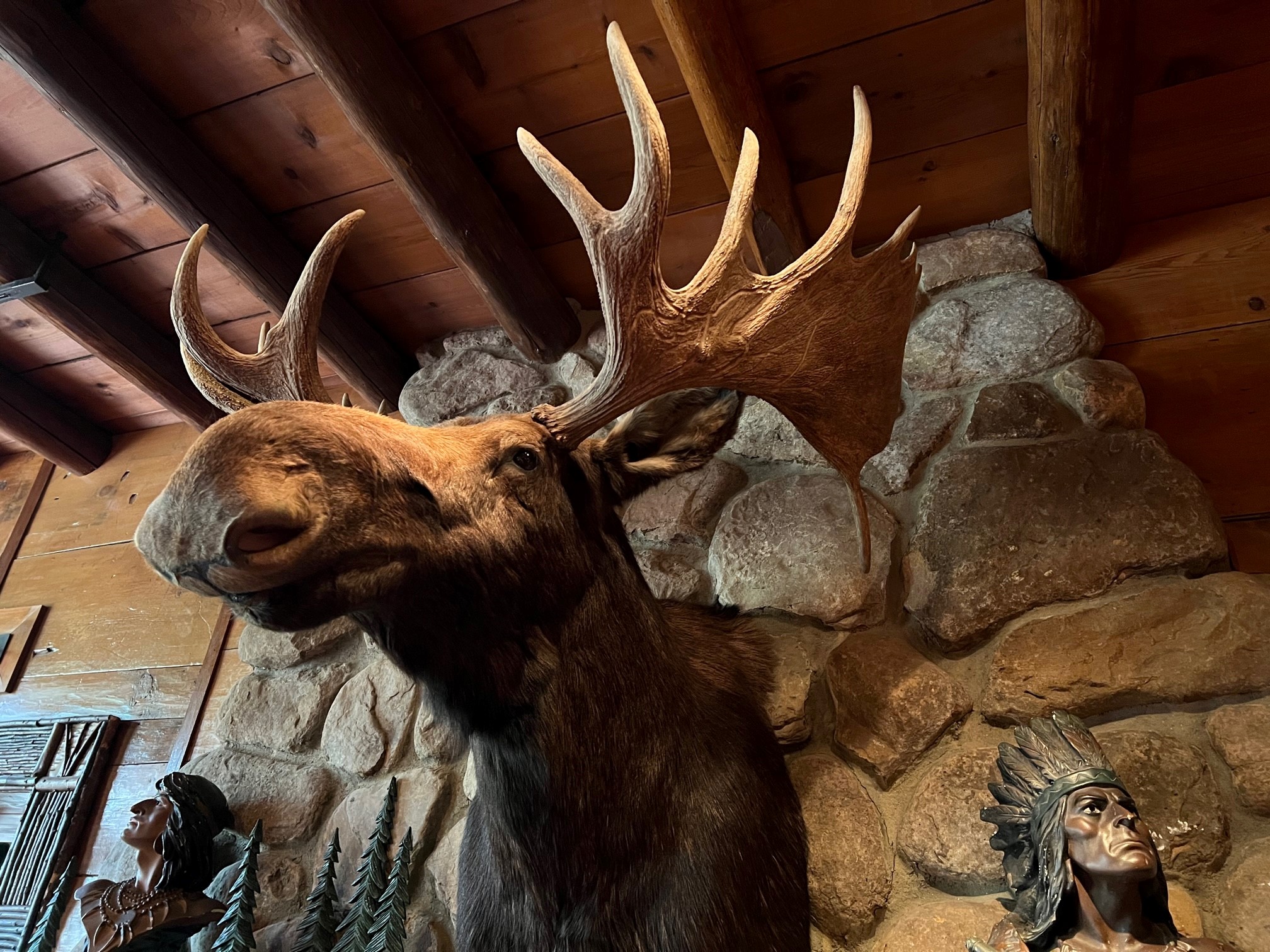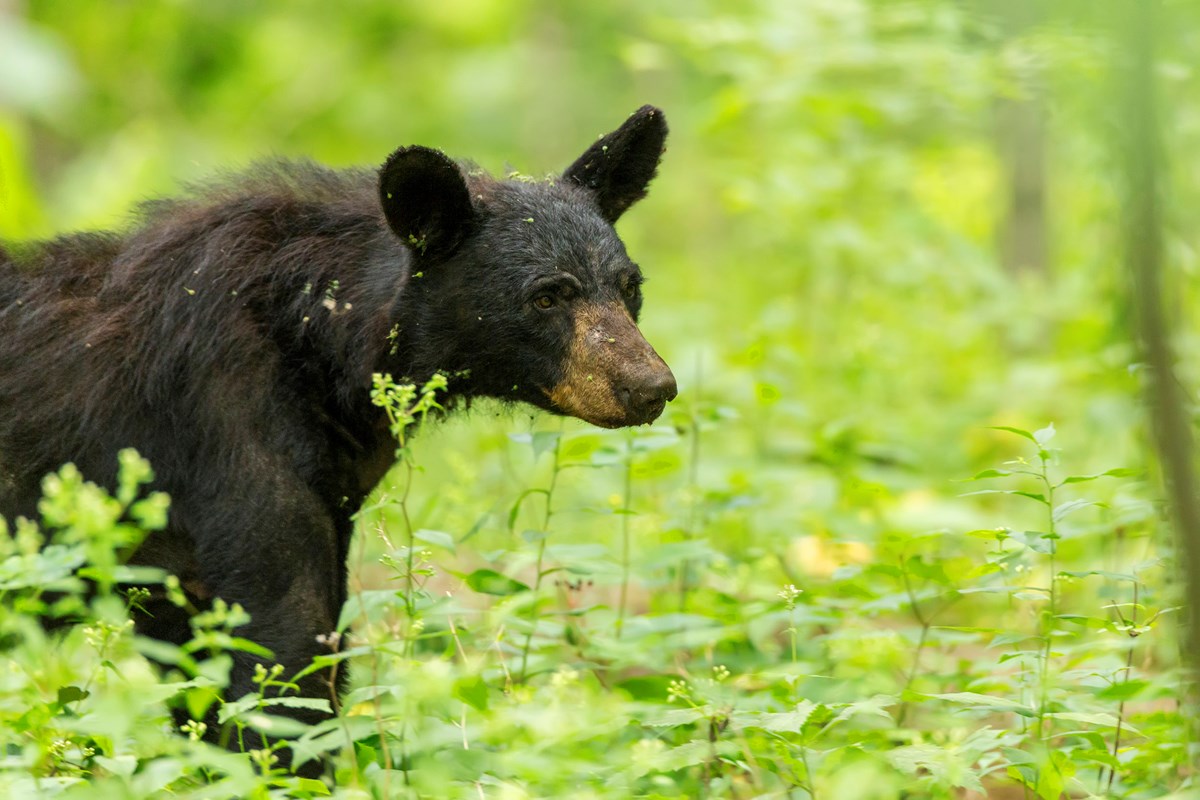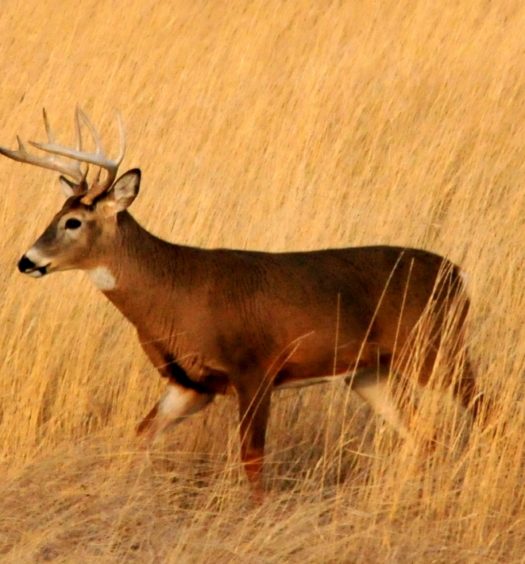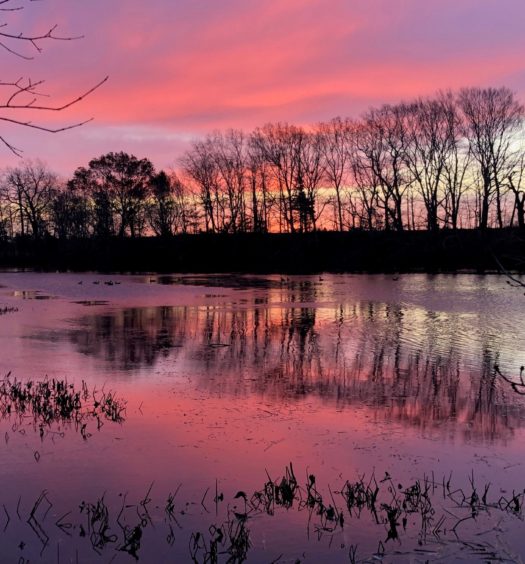I was curious to learn what large mammals roamed the lands of the Narragansett, Wampanoags, and Nipmucs in what is now Rhode Island, around the time of Roger Williams’s arrival at Providence in 1636. I discovered that the following large mammals once roamed throughout Rhode Island but no longer do so: wolves, moose and mountain lions. Black bears, by contrast, are occasionally still spotted in the state. (This is the first of a three-part series of articles on the history of mammals in Rhode Island)
Before the arrival of Europeans, Native peoples hunted for game only as they needed food and clothing. For generations there was a balance between large mammals and human hunters. The arrival of white settlers radically altered that balance, in Rhode Island, as elsewhere in New England and the rest of the East Coast of North America.
The fur trade introduced by white Europeans led Native peoples to increase their hunting of mammals, particularly beaver used for hats in Europe. Guns introduced by Europeans made killing easier for Indians and whites alike. What mostly changed and devastated the New England landscape was white settlers clearing the land to create farms to grow crops and raise livestock. Numerous forests were cut down and plowed into farms. Not only were Narragansetts, Wampanoags and Nipmucs pushed off their lands, many mammals were hunted to the brink of extinction—at least within Rhode Island.
From the time of the late 17th century deep into the 19th century, farming was vital to the state’s economy. This can be seen in Rhode Island’s forests today, where stonewalls are still prevalent. Large mammals, needing vast forests to thrive and survive, lost most of their natural habitat.
For this article, I relied mostly on A Key to the Language of America, written by Roger Williams in 1643, just seven years after he founded Providence. I used a wonderful 2019 publication published by Westholme Publishing called the Tomaquag Museum edition.
Williams’s Key was the first book published in English on Indian languages of North American Indians. Of course, Williams focused on the language of the Narragansetts, who dominated the southern mainland of Rhode Island and most of the rest of the mainland of Rhode Island at the time of, and before the arrival of, white settlers in southern New England. While the Narragansetts did hunt for wild birds and caught fish, the hunting of large mammals, and the use of them for food and clothing, was vital to them. As a result, Williams mentions many types of large animals.
Wolves used to roam what is now Rhode Island and they were feared. Williams called them “a fierce blood-sucking persecutor.” He explained that Narragansett hunters would sometimes leave traps for deer, only to see one caught but already devoured by wolves to the bone. The Narragansetts even had a term for it: “the wolf has robbed me.” Williams wrote that it was common for a wolf to chase a deer for ten miles or so before catching it. Williams added that on occasion a hunter made a hole in the ground as a trap for a wolf and killed it if caught. A black wolf was greatly prized for its fur coat. (The editors of the Tomaquag Museum edition write, “To the Narragansetts today, the wolf symbolizes strength and unity.”)
This manner of hunting wolves was learned by early white settlers. Horace A. Keach, in his 1856 history of Burrillville, wrote:
There were once wolves in Burrillville. There are “wolf pits” on the west of Paulson’s shingle mill. The old settlers used to trap them by digging deep pits, with the bottom full of sharp stakes, and the surface covered and well baited. A hill in this region still retains the name of “Wolf Hill.”
Wolves were a major concern for the early white settlers, who sought to protect their precious livestock. Even Roger Williams once led a “grand hunt” to “extirpate” wolves from the colony of Rhode Island. He was only moderately successful, however, as wolves continued to be a source of annoyance to farmers raising sheep or cattle.
Providence officially created a bounty in January 1659, when it was ordered that “whosoever shall from this time forward kill any wolves, that they shall have for each wolf, a half penny a head for each head of cattle . . . provided they kill them within Providence Limits.” In 1668 Rhode Islanders managed to collect 53 pounds to reward the killing of wolves.
During King Philip’s War (or Metacom’s War), the recently-created farms of white settlers in North and South Kingstown had been devastated. Returning settlers noted that the towns “became a desolate wilderness againe . . . replenished with howling wolves and other wild creatures.”
Wolves remained so common by 1703 that Rhode Island authorities passed yet another bounty law, paying as much as five English pounds for particularly notorious animals. About the same time, one elderly resident of the village of Warwick just south of Providence was said to sit at his window on moonlit nights so as “to shoot the wolves when they come howling too near for quiet sleep.”
In 1710, the bounty on taking a wolf was just one pound. In 1715, the bounty was reduced to thirty shillings, but hunters refused to hunt for so little. Two years later the bounty was increased to five pounds and later to ten pounds. Finally, in 1739, the bounty was made thirty pounds and under this stimulus the wolves were largely exterminated from Rhode Island.
Legends abound regarding the last wolf killed in a particular area of Rhode Island. Joseph P. Hazard, in a letter written in 1882, stated that he had heard that the great diarist, Thomas B. (“Nailer Tom”) Hazard of South Kingstown (born 1756, died 1845), reported that the last wolf in South Kingstown and North Kingstown “was killed in the woods north of the Snuff Mill (Roomes woods), when he (Nailer Tom) was a boy.” That would have been about 1766, and the Snuff Mill would have been located on what is now the Gilbert Stuart Birthplace and Museum in North Kingstown.
An online article on Westerly’s Wolf Island Trail states that “Wolf Island is a piece of higher ground in the heart of the swamp and legend has it that the last wolf to be found in Westerly was hunted and killed here in 1708.”
- Earl Clauson wrote in a 1936 Evening Bulletin article that Wolf Rocks in Exeter, by local tradition, was where the last wolf was killed in the surrounding area. The year is not provided.
Today wolves are extinct in the Northeast. These were not the large Arctic wolves that were relocated to Yellowstone National Park in the 1990s. Rather, they were a smaller breed. Still, they were a fierce predator. Wolf Hill and Wolf Hill Forest Preserve in Smithfield and Wolf Rocks in Exeter are reminders that wolves once roamed in the state.
The last wolves to have appeared in Rhode Island may have been Jethro and Clem, two formerly wild-turned-friendly wolves, who appeared at List Auditorium at Brown University in 1972.
One species that once roamed the lands of the Narragansetts but is no longer found in Rhode Island is the huge North American moose. Roger Williams referred to the species as the “great ox, or rather, a red deer.” The Narragansett name for the animal is close to the term later adopted by the English—moòsóog or moòse.
The Moshassuck River, which wanders through Providence and to the east joins the Woonasquatucket River, is named for an Indian word said to mean “river where moose watered” or “moose hunting grounds.” It is also said that Narragansetts gave the name Moshassuck to the east side of Providence at India Point. There used to be a Moosup Pond in Providence County and still is a Moosup River near Greene, the names of which were likely derived from the Indian name for moose.
It is remarkable that moose were once prevalent in the state. The introduction of muskets made them easier to kill. Moose need a lot of swampy areas to retreat to in case they are confronted by predators. Apparently, the Great Swamp in South County was not big enough for them to survive predators and white hunters. They also need areas of light snow in the winter to avoid wolves and other predators. In the seventeenth and eighteenth centuries, Rhode Island was much colder than it is now.
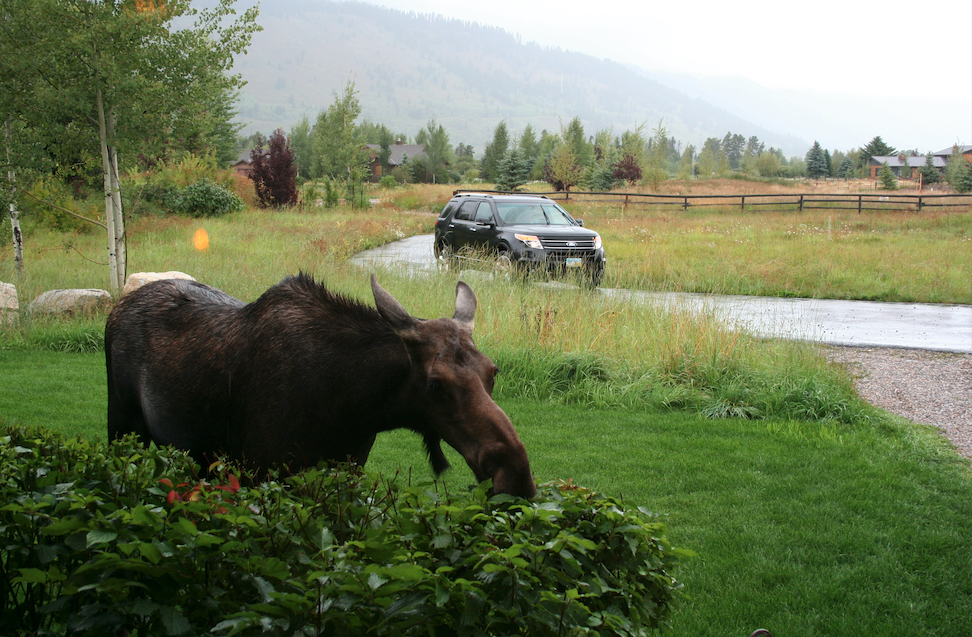
Moose eating leaves on bushes in front of cabin rented by the author at Grand Teton National Park in 2014. The author’s wife, Margaret, is in the car (the Author)
Today, most moose in New England are in Maine, with several thousand in the northern parts of New Hampshire and Vermont. Moose were recently reintroduced in parts of western Massachusetts and northern Connecticut. But moose have not been reintroduced in Rhode Island, and with the global warming phenomenon it seems unlikely they ever will be.
Still, there have been some sightings of moose and moose tracks in northwest Rhode Island, as reported in the Providence Journal in 1985, 1992 and 1997. In 1985, a bull moose with massive antlers was shot with a tranquilizer dart near the Adult Correctional Institutions in Cranston off Route 95. In 1997, a young bull moose, wandering between Burrillville and Johnston, was twice struck by cars, but the animal and people apparently all escaped without injury.
In his Key, Williams does not mention mountain lions (also known as cougars or pumas). Presumably they were as difficult to see in the wild in Roger Williams’s time as they are today. They were the largest of the big cats found in the Northeast, some weighing nearly 150 pounds and as long as nine feet from head to tail. Mountain lions were present throughout the Americas when the Europeans first arrived. In 1733, Scituate granted a bounty on “wild cats” that were “killing sheep, goats and other small creatures.”
Naturalist John James Audubon wrote that by the same year, “the animal, which has excited so much terror in the minds of the ignorant and timid, has been nearly exterminated in all our Atlantic states, and we do not recollect a single well authenticated instance where any hunter’s life fell sacrifice to a Cougar hunt.”
Clearcutting of forests in the 18th and 19th centuries wiped out most of the mountain lions’ natural habitat. Deer were the primary prey of cougars, but deer populations declined drastically from all the new farms created out of the forests, as well as from hunting. Also the cougars sometimes killed livestock. More than 200 years of bounties also picked off the animals, one by one.
The last mountain lion allegedly killed in Rhode Island has an interesting history. It was reportedly killed in West Greenwich sometime in 1847-1848. One of the James brothers is supposed to have “collected” it. The specimen was then donated by Tillinghast Olney to the Franklin Society of Providence, which had developed an extensive collection of natural items. Then it was acquired by the Boston Society of Natural History Museum, probably before 1922 when the Franklin Society disbanded. In 1946, Harvard University’s Museum of Comparative Zoology purchased the specimen, and that is where it is held now. The skull was removed from the skin in 1982. There are now images of different parts of the skull on the museum’s website (see the link below under Sources—Mountain Lions).
The “Northeastern Panther” is in a list of mammals created in 1900 by the Newport Natural History Society of mammals known to have inhabited Rhode Island.
Mountain lions may now be extinct in New England. Scientists say that mountain lions need plenty of deer and large swaths of contiguous forest to survive. If one includes the contiguous forests of Connecticut, it is possible that some mountain lions have entered Rhode Island recently.
There have been claimed sightings of mountain lions in recent years in Connecticut and Rhode Island, some reported in the Providence Journal, but no hard proof. Some have been escaped or released pets. The best documented one in southern New England, which was killed by a car in Connecticut in 2011, was found to have travelled from South Dakota, and had been seen in Midwest states in 2009.
No photograph has appeared of one in Rhode Island, including by cameras set up on trails. One expert was quoted recently in the Providence Journal, “In Connecticut as well as in Rhode Island, there are so many people who spend time outdoors. We don’t have empty wilderness in the classic sense. Yet with all those people outdoors, no one has found any [mountain lion] tracks.”
In 2011, the U.S. Fish & Wildlife Service, after a study reviewing the evidence of the existence of the eastern cougar from Maine to South Carolina, and west from Michigan to Tennessee, declared it was extinct. This conclusion did not cover the Florida panther, which at the time had a breeding population of about 120 to 160 animals in southwestern Florida.
Still, there are those, including Rhode Islanders, who passionately believe that mountain lions do still exist in New England. That may be the topic of a future article on this website.
In his Key, Williams does not mention bison or elk. Scientists believe that a species of bison and a species of elk roamed parts of the Northeast in prehistoric times, but as yet there is no evidence of their coming to Rhode Island.
Williams mentions hunting bears. Presumably, this was the North American black bear. Catching one must not have been common because Williams does not refer to its fur as an article of clothing, as he does, for example, for wolves, moose, and fox.
The Rhode Island Department of Natural Resources reported in 1968 that black bears were once common in Rhode Island but had vanished by 1800.
Black bears lead solitary lives except during breeding season or when rearing cubs. A male’s might range between 12 and 60 miles, while females only range 5 to 7 miles. Male bears weigh on the average from 150 to 450 pounds and female bears from 100 to 250 pounds.
As farms were abandoned in Rhode Island and elsewhere in New England, forests have regenerated to some extent, allowing black bear populations to recover in recent decades. Black bear populations began increasing in Massachusetts and Connecticut in the late 2000s, and as a result so did sightings in Rhode Island. Most reports of black bears are from the northwest part of the state, but in 2008 a black bear was spotted spending a morning roaming the banks of Narrow River in Narragansett and in 2015 there were reports that a black bear had killed four sheep in South Kingstown.
In late April 2022 there was a report of a large black bear, around 250 pounds, that had just ended hibernation and was on the hunt for bird feed in bird feeders in South Kingstown. One family caught the bear at night on camera knocking down a six-foot metal pole on which a bird-feeder stood and that the bear was as tall as the pole. The occupants of the house said that this was the third spring in a row the bear had visited their yard (visiting just once a year). My own sister-in-law, Tricia McBurney, in early May, was shocked to see a large black bear in her yard in West Kingston, perhaps the same bear. The bear took down a birdfeeder attached to the house that was almost seven-feet high and then quickly disappeared into the adjoining woods.
More black bears may be coming south and east to Rhode Island soon, despite it being the second-most densely populated state in the country. The Boston Globe recently reported that in the 1970s, there were only about one hundred of them in Massachusetts. Today, MassWildlife, the state’s conservation agency that has overseen their rebound, estimates there are about 4,500 in Massachusetts. A Connecticut’s wildlife division official in March 2022 estimated that there were 1,200 black bears in Connecticut, most in the northwest and fewer in the east.
A DEM official reported in 2021 that there were about 60 sightings in the prior several years in Glocester, while Burrillville had about ten.
However, despite increased sightings of black bears from time-to-time, the Rhode Island bear population remains low. A wildlife biologist at DEM estimated in 2021 that fewer than ten black bears reside in Rhode Island, and perhaps even fewer than five. The biologist was also unable to confirm that there were any bears then breeding in the state.
Next week’s article will discuss smaller animals that roamed in Rhode Island in Roger Williams’s time—and when deer almost became extinct in the state.
Sources
General:
The version of Roger Williams’s A Key into the Language of America I used was the Tomaquag Museum Edition, published by Westholme Publishing of Yardley, Pennsylvania, in 2019. Its editors are Dawn Dove, Sandra Robinson, Lorén Spears, Dorothy Herman, and Kathleen J. Bragdon.
William Cronon, Changes in the Land, Indians, Colonists, and the Ecology of New England (New York, NY: Hill and Wang, 1983), 97-107.
John M. Cronan and Albert Brooks. The Mammals of Rhode Island. Wildlife Pamphlet No. 6. Wakefield, RI: Rhode Island Department of Natural Resources, Division of Conservation, 1968.
Wolves:
Samuel Greene Arnold. History of the State of Rhode Island and Providence Plantations. Vol 1 (New York: D. Appleton, 1860), 154.
Sidney Smith Rider. The Lands of Rhode Island: As They Were Known to Caunounicus and Miantunnomu When Roger Williams Came in 1636 (Providence: Privately Printed, 1904), 34 and 179.
John R. Bartlett, editor. Records of the Colony of Rhode Island and Providence Plantations in New England. Vol. 3 (Providence: Knowles, Anthony, 1858), 59 (howling wolves).
Letter, Feb. 10, 1882. Contributed by Joseph P. Hazard of the “Castle,” South Kingstown, R.I. In The Narragansett Historical Register, edited by James N. Arnold, vol. 1 (Hamilton, R.I., Narragansett Historical Publishing Company, 1882-83), 225.
Robert Geake. “When wolves ranged New England.” Providence Journal, Feb. 7, 2014 (bounties).
Horace A. Keach. Burrillville: As it Was, and As it Is. Providence: Knowles, Anthony & Co., 1856.
“The Wild Heart of Westerly; the Crandall Family Preserve.” Online article accessed Dec. 17, 2019, at https://westerlylife.com/the-wild-heart-of-westerly-crandall-family-preserve/.
- Earl Clausen. “These Plantations.” Evening Bulletin (Providence, RI), Dec. 16, 1936.
“Jethro and Clem, Two Friendly but Wild Wolves, will be Appearing at Brown University’s List Auditorium at 7 pm Tomorrow.” Providence Journal, April 2, 1972.
Mountain Lions:
Cougar skull and skin from West Greenwich, RI, 1847-48. Museum of Comparative Zoology, Harvard University. No. 42958 (and no. Cat349). Images and report of its history and acquisition are available at https://mczbase.mcz.harvard.edu/guid/MCZ:Mamm:42598.
Melanie Lefkowitz. “Does the Eastern Mountain Lion Roam the Woods of Rhode Island.” Providence Journal, Jan. 3, 1999.
Hugh Markey. “Do Pumas Prowl R.I., or Just Our Imaginations.” Providence Journal, Dec. 8, 2019.
Edgar A. Mearns. The Native Mammals of Rhode Island (Newport, RI: Newport Natural History Society, July 1, 1900).
Jan Ellen Spiegelnov. “How Far East? Not too Far.” New York Times, Nov. 4, 2007 (mountain lions).
“Scituate bounty on wild cats. Sketches of Scituate.” Providence Journal, Sept. 27, 1854.
U.S. Fish & Wildlife Service. “Comments sought on eastern cougar, ” Feb. 28, 2007. Online at https://www.fws.gov/story/2007-02/comments-sought-eastern-cougar.
U.S. Fish & Wildlife Service. “U.S. Fish and Wildlife Service concludes eastern cougar extinct,” March 2, 2011. Online at https://www.fws.gov/story/2011-03/us-fish-and-wildlife-service-concludes-eastern-cougar-extinct.
Moose:
Ken Mingis and S. Robert Chiappi. “2 Moose? R.I. is in a Rut.” Providence Journal, Oct. 6, 1985.
“Moose Sightings in Rhode Island.” Providence Journal, Oct. 6, 1985.
“Outdoor Notes Moose Tracks Found in Eastern Coventry.” Providence Journal, Nov. 16, 1997. (Also 315 pound deer)
Black Bears:
Billy Baker. “The New Golden Age of Wildlife in New England.” Boston Globe, April 17, 2002. Online at https://www.bostonglobe.com/2022/04/17/metro/new-golden-age-wildlife-new-england/?s_campaign=8315.
Arlene Fleming. “From North to South, Bear Attracts Attention Across R.I.” Providence Journal. May 28, 2008.
- Iacabbo. “Reports of Black Bears on the Rise in Northern RI,” Aug. 23, 2021. NRI Now News. Online at https://nrinow.news/2021/08/23/reports-of-black-bears-on-the-rise-in-northern-ri/.
Jesse Leavenworth. “More than 1,200 Black Bears are Waking Up in Connecticut. What to Know about Trash, Pets and Those Ear Tags.” Hartford Courant, March 25, 2022. Online at https://www.courant.com/news/connecticut/hc-news-ct-bear-aware-20220325-y43iigli65h4jaijfk2r4mdzfe-story.html.
Todd McLeish. “Despite Perceptions, Black Bear Numbers Remain Low,” May 14, 2021. EcoRI News. Online at https://ecori.org/2021-5-11-despite-perceptions-bear-numbers-in-rhode-island-remain-low/#:~:text=Charles%20Brown%20agreed.,perhaps%20even%20fewer%20than%20five.
Rhode Island Department of Environmental Management. “American Black Bear.” Available as a PDF at http://www.dem.ri.gov/programs/bnatres/fishwild/pdf/blackbear.pdf.
Tatiana Pina. “Wildlife. Black Bear Reportedly Kills 4 Sheep in S. Kingstown.” Providence Journal, Nov. 5, 2010.
Donita Naylor, “Big Black Bear Pays Annual Visit to South Kingstown,” Providence Journal, April 25, 2022.

